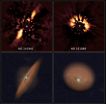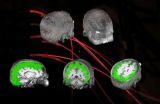(Press-News.org) Astronomers using NASA's Hubble Space Telescope have applied a new image processing technique to obtain near-infrared scattered light photos of five disks observed around young stars in the Mikulski Archive for Space Telescopes database. These disks are telltale evidence for newly formed planets.
If astronomers initially miss something in their review of data, they can make new discoveries by revisiting earlier data with new image processing techniques, thanks to the wealth of information stored in the Hubble data archive. This is what Rémi Soummer, of the Space Telescope Science Institute (STScI) in Baltimore, Md., and his team recently did while on a hunt for hidden Hubble treasures.
The stars in question initially were targeted with Hubble's Near Infrared Camera and Multi-Object Spectrometer (NICMOS) based on unusual heat signatures obtained from NASA's Spitzer Space Telescope and the Infrared Astronomical Satellite that flew in 1983. The previous data provided interesting clues that dusty disks could exist around these stars. Small dust particles in the disks might scatter light and therefore make the disks visible. But when Hubble first viewed the stars between 1999 and 2006, no disks were detected in the NICMOS pictures.
Recently, with improvements in image processing, including algorithms used for face-recognition software, Soummer and his team reanalyzed the archived images. This time, they could unequivocally see the debris disks and even determine their shapes.
The NICMOS instrument, which began collecting data in 1997, has been so cutting-edge that ground-based technology only now is beginning to match its power. Because Hubble has been in operation for almost 24 years, it provides a long baseline of high-quality archival observations.
"Now, with such new technologies in image processing, we can go back to the archive and conduct research more precisely than previously possible with NICMOS data," said Dean Hines of STScI.
"These findings increase the number of debris disks seen in scattered light from 18 to 23. By significantly adding to the known population and by showing the variety of shapes in these new disks, Hubble can help astronomers learn more about how planetary systems form and evolve," said Soummer.
The dust in the disks is hypothesized to be produced by collisions between small planetary bodies such as asteroids. The debris disks are composed of dust particles formed from these grinding collisions. The tiniest particles are constantly blown outward by radiation pressure from the star. This means they must be replenished continuously though more collisions. This game of bumper cars was common in the solar system 4.5 billion years ago. Earth's moon and the satellite system around Pluto are considered to be collisional byproducts.
"One star that is particularly interesting is HD 141943," said Christine Chen, debris disk expert and team member. "It is an exact twin of our sun during the epoch of terrestrial planet formation in our own solar system."
Hubble found the star exhibits an asymmetrical, edge-on disk. This asymmetry could be evidence the disk is being gravitationally sculpted by the tug of one or more unseen planets.
"Being able to see these disks now also has let us plan further observations to study them in even more detail using other Hubble instruments and large telescopes on the ground," added Marshall Perrin of STScI.
"We also are working to implement the same techniques as a standard processing method for NASA's upcoming James Webb Space Telescope," said STScI teammate Laurent Pueyo. "These disks will also be prime targets for the Webb telescope."
Soummer's team has just begun its work. They next will search for structures in the disks that suggest the presence of planets.
INFORMATION:
The Hubble Space Telescope is a project of international cooperation between NASA and the European Space Agency. NASA's Goddard Space Flight Center in Greenbelt, Md., manages the telescope. STScI in Baltimore conducts Hubble science operations. STScI is operated for NASA by the Association of Universities for Research in Astronomy, Inc., in Washington.
For images and more information about Hubble, visit:
http://www.nasa.gov/hubble
Astronomical forensics uncover planetary disks in NASA's Hubble archive
2014-04-25
ELSE PRESS RELEASES FROM THIS DATE:
Study suggests targeting B cells may help with MS
2014-04-24
PHILADELPHIA – A new study suggests that targeting B cells, which are a type of white blood cell in the immune system, may be associated with reduced disease activity for people with multiple sclerosis (MS). The study is released today and will be presented at the American Academy of Neurology's 66th Annual Meeting in Philadelphia, April 26 to May 3, 2014.
For the study, 231 people with relapsing-remitting MS received either a placebo or one of several low dosages of the drug ofatumumab, which is an anti-B cell antibody, for 24 weeks, with the first 12 weeks making up ...
New guidelines aim to improve care for babies with heart problems in the womb
2014-04-24
Fetal heart experts working with the American Heart Association have developed guidelines to help healthcare providers care for unborn babies with heart problems, as well as their families.
The statement, Diagnosis and Treatment of Fetal Cardiac Disease, is published in the American Heart Association journal, Circulation.
"Congenital heart disease is the most common birth defect that can result in either death or significant health problems in newborn babies," said Mary T. Donofrio, M.D., lead writer of the statement, and director of the Fetal Heart Program and Critical ...
Genetic alterations in shared biological pathways as major risk factor for ASD
2014-04-24
A substantial proportion of risk for developing autism spectrum disorders (ASD), resides in genes that are part of specific, interconnected biological pathways, according to researchers from the Icahn School of Medicine at Mount Sinai, who conducted a broad study of almost 2,500 families in the United States and throughout the world. The study, titled "Convergence of Genes and Cellular Pathways Dysregulated in Autism Spectrum Disorders," was first published online in the American Journal of Human Genetics on April 24.
ASD affects about one percent of the population ...
Controlling brain waves to improve vision
2014-04-24
Have you ever accidently missed a red light or a stop sign? Or have you heard someone mention a visible event that you passed by but totally missed seeing?
"When we have different things competing for our attention, we can only be aware of so much of what we see," said Kyle Mathewson, Beckman Institute Postdoctoral Fellow at the University of Illinois. "For example, when you're driving, you might really be concentrating on obeying traffic signals."
But say there's an unexpected event: an emergency vehicle, a pedestrian, or an animal running into the road—will you actually ...
Computer program could help solve arson cases
2014-04-24
Sifting through the chemical clues left behind by arson is delicate, time-consuming work, but University of Alberta researchers teaming with RCMP scientists in Canada, have found a way to speed the process.
A computer program developed by University of Alberta chemistry professor James Harynuk, his team of graduate and undergraduate researchers and the Royal Canadian Mounted Police National Forensic Laboratory Services, can cut the need for extra levels of human analysis, reducing the waiting time to find out the cause of a deliberately set fire.
That means quicker ...
'Horsing around' reduces stress hormones in youth
2014-04-24
PULLMAN, Wash. – New research from Washington State University reveals how youth who work with horses experience a substantial reduction in stress – and the evidence lies in kids' saliva.
The results are published in the American Psychological Association's Human-Animal Interaction Bulletin this month.
Pendry-80"We were coming at this from a prevention perspective," said Patricia Pendry, a developmental psychologist at WSU who studies how stress "gets under the skin" and the effects of prevention programs on human development. "We are especially interested in optimizing ...
JCI online ahead of print table of contents for April 24, 2014
2014-04-24
Ex vivo expansion of hematopoietic stem cells from cord blood
Compared to hematopoietic stem cells (HSCs) isolated from adults, HSCs isolated from cord blood (CB) have enhanced proliferative potential and can lead to hematological reconstitution when engrafted in children with hematological malignancies or genetic defects. Unfortunately, small numbers of HSCs are present in single CB collections, limiting their use as grafts for adults. For several decades investigators have used a variety of strategies to expand the numbers of CB HSC ex vivo with limited success. Evidence ...
Microscopic organism plays a big role in ocean carbon cycling, Scripps scientists discover
2014-04-24
It's broadly understood that the world's oceans play a crucial role in the global-scale cycling and exchange of carbon between Earth's ecosystems and atmosphere. Now scientists at Scripps Institution of Oceanography at UC San Diego have taken a leap forward in understanding the microscopic underpinnings of these processes.
When phytoplankton use carbon dioxide to make new cells, a substantial portion of that cellular material is released into the sea as a buffet of edible molecules collectively called "dissolved organic carbon." The majority of these molecules are eventually ...
What makes psychotic teens more at risk for suicide than other groups with psychosis?
2014-04-24
Suicide is a general risk for people with psychosis. According to the Journal of Psychiatry, 20 percent to 40 percent of those diagnosed with psychosis attempt suicide, and up to 10 percent succeed.
And teens with psychotic symptoms are nearly 70 times more likely to attempt suicide than adolescents in the general population, according to a 2013 study in JAMA Psychiatry.
But what contributes to such high numbers?
Jane Timmons-Mitchell, PhD, from Case Western Reserve University's social work school, and Tatiana Falcone, MD, from the Cleveland Clinic, reviewed studies ...
Solving the mystery of a superluminous supernova
2014-04-24
This release is available in Japanese.
An exceptionally bright supernova reported in 2013 is so luminous, a new study reports, because a lens in the sky amplified its light. The discovery of the lens settles an important controversy in the field of astronomy.
In 2010, a team of scientists observed a supernova, PS1-10afx, shining brighter than any other in its class.
"PS1-10afx is like nothing we have seen before," said senior author Robert Quimby of the University of Tokyo's Kavli Institute for the Physics and Mathematics of the Universe.
Its exceptional glow ...

